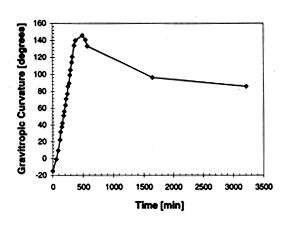| Navigation: |

|

|

|
The general way of measuring gravitropic curvature during experiments is shown in picture 2. With a protractor lined up along the top part of the shoot angles could be recorded with an accuracy of about 1o.

|
|
Figure 8. The gravitropic response of a snapdragon shoot during the 'time-lapse' experiment depicted in picture 1. The slides were projected, after wich the angles could be measured with a standard protractor. |